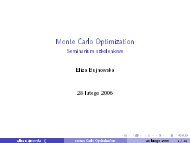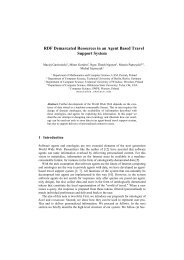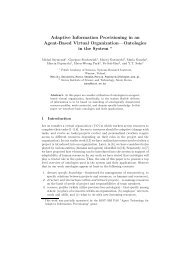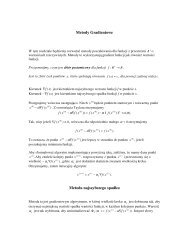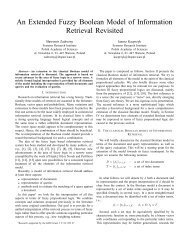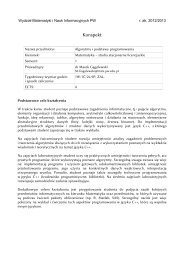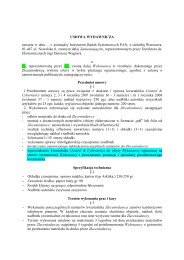Knowledge Management in an E-commerce System
Knowledge Management in an E-commerce System
Knowledge Management in an E-commerce System
Create successful ePaper yourself
Turn your PDF publications into a flip-book with our unique Google optimized e-Paper software.
<strong>Knowledge</strong> <strong>M<strong>an</strong>agement</strong> <strong>in</strong> <strong>an</strong> E-<strong>commerce</strong> <strong>System</strong> 2hum<strong>an</strong> <strong>in</strong>teraction. In e-<strong>commerce</strong> the primary medium of knowledge acquisition, exch<strong>an</strong>ge <strong>an</strong>d application is thecomputer; this fundamental difference raises m<strong>an</strong>y issues <strong>in</strong> the tr<strong>an</strong>slation of economic theories of knowledge to thedoma<strong>in</strong> of e-<strong>commerce</strong>. Here we wish to survey some of these issues, as well as speculate on some possible approaches toconfront<strong>in</strong>g them. S<strong>in</strong>ce e-<strong>commerce</strong> is a relatively new field, questions of how (or if it is possible) to tr<strong>an</strong>slate thetheoretical <strong>an</strong>d practical experience of hum<strong>an</strong>-driven economies ga<strong>in</strong>ed from years past <strong>in</strong>to a form that is applicable <strong>in</strong>the e-<strong>commerce</strong> doma<strong>in</strong> are still open. Before attempt<strong>in</strong>g to address a few of these questions, we will first look at some ofthe differences between e-<strong>commerce</strong> <strong>an</strong>d traditional <strong>commerce</strong> <strong>in</strong> the context of knowledge m<strong>an</strong>agement functions, <strong>in</strong>Section 2. The process of knowledge creation <strong>in</strong> the context of e-<strong>commerce</strong> will be summarized <strong>in</strong> Section 3. Typicalknowledge acquisition techniques result <strong>in</strong> what we will name “low level knowledge”, a form of knowledge that must becoerced <strong>in</strong>to useful frameworks for particular knowledge consumers <strong>in</strong>side <strong>an</strong>d outside the system. This process will bediscussed <strong>in</strong> Sections 4 <strong>an</strong>d 5. F<strong>in</strong>ally, even though the processes of knowledge acquisition <strong>an</strong>d knowledge tr<strong>an</strong>sfer mayseem difficult, that of knowledge application is considerably more so. We will address this application <strong>in</strong> Section 6.2. COMMERCE VS. E-COMMERCE AND THE KNOWLEDGE PROCESSESThe tr<strong>an</strong>slation of knowledge m<strong>an</strong>agement functions from the doma<strong>in</strong> of <strong>commerce</strong> to that of e-<strong>commerce</strong> is largely aprocess of explicat<strong>in</strong>g what is now implicit – <strong>an</strong> end-goal which has much <strong>in</strong> common to that of the classical approach toartificial <strong>in</strong>telligence, which seeks to comprehensively formalize hum<strong>an</strong> knowledge <strong>an</strong>d knowledge of processes <strong>in</strong> orderto replicate (or at least appear to replicate) hum<strong>an</strong> <strong>in</strong>telligence. The <strong>an</strong>alogy to artificial <strong>in</strong>telligence extends further: oneof the fundamental goals of e-<strong>commerce</strong> is to reproduce the (presumably positive) experiences of brick-<strong>an</strong>d-mortar<strong>commerce</strong> – the helpful sales assist<strong>an</strong>t, <strong>an</strong> easy-to-browse selection, etc. Obviously, not all aspects of <strong>commerce</strong> c<strong>an</strong> bereplicated <strong>in</strong> e-<strong>commerce</strong>. For the time be<strong>in</strong>g it is impossible to touch the sweater or to smell the perfumes, <strong>an</strong>d soe-<strong>commerce</strong> must apply one of its most import<strong>an</strong>t strategies: what c<strong>an</strong>not be replicated must be replaced. Creat<strong>in</strong>gacceptable substitutes for these miss<strong>in</strong>g experiences is the key challenge for e-<strong>commerce</strong>, <strong>an</strong>d the purpose of most of its“<strong>in</strong>telligent” processes. <strong>Knowledge</strong> m<strong>an</strong>agement is the cornerstone of these processes, <strong>an</strong>d the focal po<strong>in</strong>t of our contrast.No doubt, the proper start<strong>in</strong>g po<strong>in</strong>t for a broad comparison between electronic <strong>an</strong>d brick-<strong>an</strong>d-mortar <strong>commerce</strong>would be the most obvious one – the medium itself. However, <strong>in</strong> this paper we are solely <strong>in</strong>terested <strong>in</strong> how the contrastbetween e-<strong>commerce</strong> <strong>an</strong>d traditional bus<strong>in</strong>ess affects the knowledge m<strong>an</strong>agement aspects of the e-<strong>commerce</strong> system, <strong>an</strong>dhow these differences <strong>in</strong>troduce a widen<strong>in</strong>g gap <strong>in</strong> the way knowledge is m<strong>an</strong>aged <strong>in</strong> the hum<strong>an</strong>-based enterprise versusthe electronic one. While a very large number of signific<strong>an</strong>t differences between <strong>commerce</strong> <strong>an</strong>d e-<strong>commerce</strong> c<strong>an</strong> bepo<strong>in</strong>ted to, we concentrate our attention on those that play <strong>an</strong> import<strong>an</strong>t role <strong>in</strong> the context of knowledge m<strong>an</strong>agement.We divide them <strong>in</strong>to three groups: differences of scope, differences for the customer <strong>an</strong>d differences for the system.2.1 Differences of scopeAt the core of a contrast between electronic <strong>an</strong>d traditional <strong>commerce</strong> lie some essential differences <strong>in</strong> the scope ofoperation, which have signific<strong>an</strong>t impact for knowledge m<strong>an</strong>agement: the scope of commodities, the scope of time <strong>an</strong>dthe geographical scope of the market:1. While conventional stores only carry a limited supply of items (typically the most popular), onl<strong>in</strong>e stores c<strong>an</strong> offer<strong>an</strong> almost unlimited number of goods, <strong>in</strong>clud<strong>in</strong>g specialty products targeted for a relatively small niche market.Confederations of electronic merch<strong>an</strong>ts (e.g. amazon.com, which is billed as hav<strong>in</strong>g “Earth’s Biggest Selection”)act<strong>in</strong>g as <strong>in</strong>termediaries between multiple sellers <strong>an</strong>d customers, may generate a very large commodity search space[14, 33]. Moreover, assum<strong>in</strong>g the growth of the onl<strong>in</strong>e market cont<strong>in</strong>ues, one may envision <strong>an</strong> <strong>in</strong>termediary systemthat uses the complete Internet as the source of its commodities, thus mak<strong>in</strong>g its commodity space almost as large asthe space of all commodities possibly available on Earth. It is easy to see that this has <strong>an</strong> immediate effect on theknowledge-related requirements <strong>in</strong> the system. For <strong>in</strong>st<strong>an</strong>ce, while it is possible that <strong>in</strong> a small store few salespeoplec<strong>an</strong> know most of what it is to know about the offered commodities, a large e-<strong>commerce</strong> enterprise must store <strong>an</strong>dm<strong>an</strong>age <strong>an</strong> enormous amount of data about the available commodities – even if the accumulated data about eachitem is m<strong>in</strong>imal, the shear number of items makes the total amount of data very large.International Conference on Electronic Commerce Research (ICECR-5)



